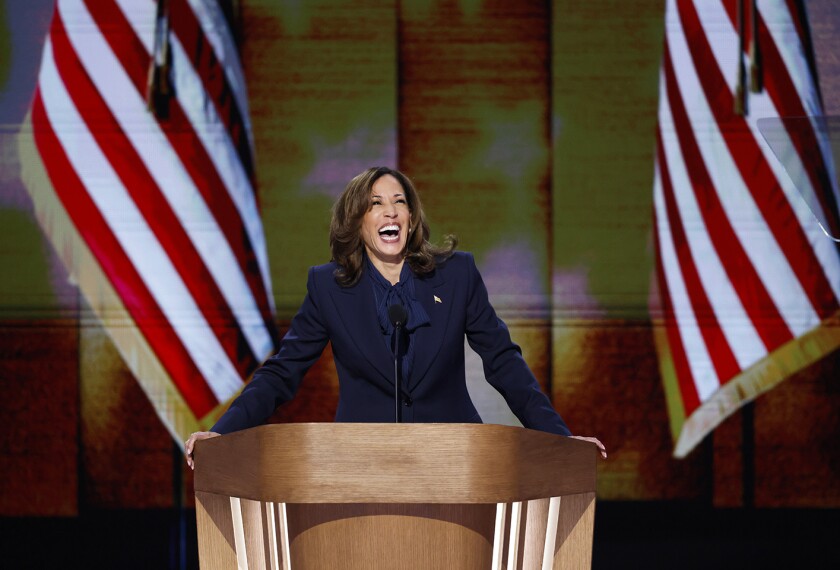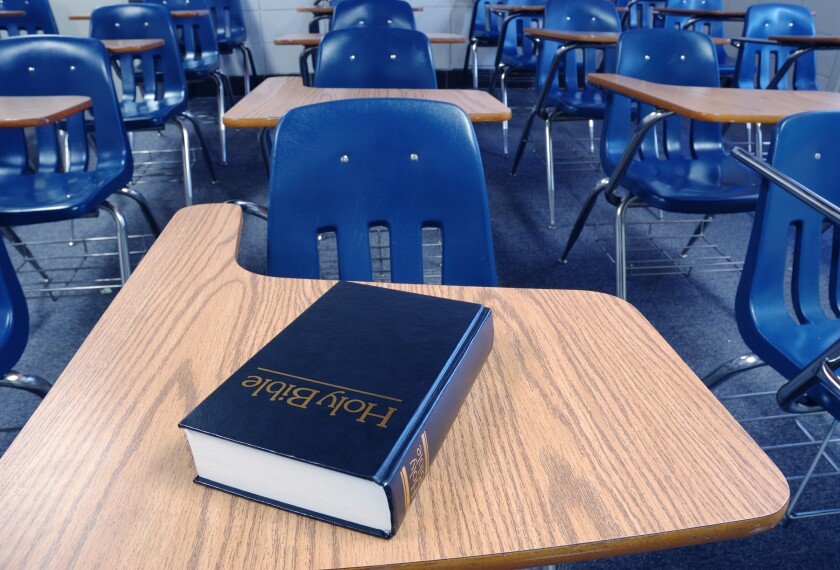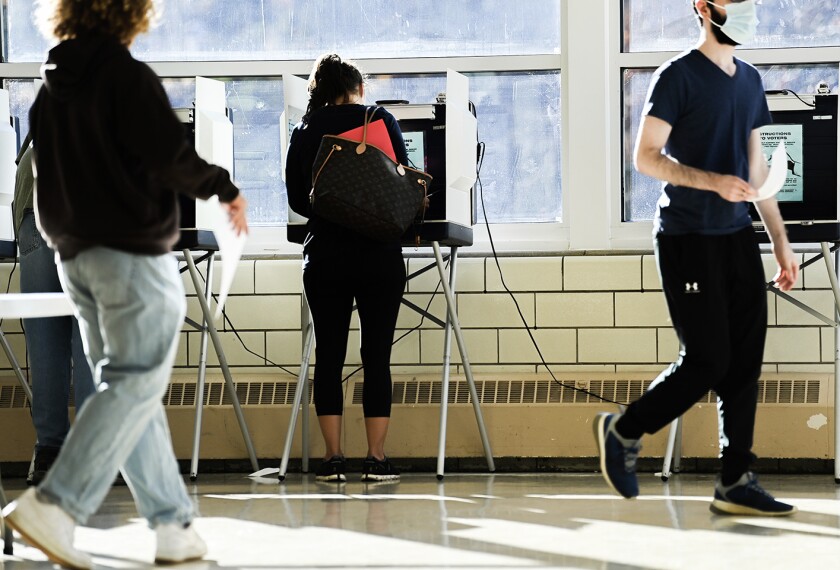David Schexnaydre Jr., a former middle school principal from Louisiana, knew he had to do something the day after Joe Biden was elected the president of the United States. The 2020 campaign between Biden and the then-incumbent president, Donald Trump, had been a long, uncomfortable, often ugly slug match.
Schexnaydre had already witnessed divisive politics rear its head in his school. A handful of students had started to form pro-Trump or pro-Biden camps around the election and would chant slogans during lunch in favor of their candidate. “Nothing [bad] had happened yet. But I felt like I had to be proactive. I had to address the election,” said Schexnaydre.
The next day, he declared to the whole school: “I’m going to tell you who I voted for.”
He waited for the audible gasps from his teachers to die down. “I voted for Harry Hurst as the best middle school!” he added, referring to their school. (Schexnaydre is now the director of secondary schools for the St. Charles Parish public school district in Luling, La.)
With the tension diffused, Schexnaydre told his students that they needed to be tolerant of each other’s views when talking about politics at school. The slogans, he said, “stopped after that.”
When a group of rioters lay siege to the U.S. Capitol just a few months later, divisive politics reemerged. This time, Schexnaydre gave his teachers specific instruction: The events of Jan. 6 could only be discussed if they were relevant to a social studies class. Teachers would have to stay “neutral and objective.”
“We wanted to give the kids some space to talk about it and be inclusive, but we couldn’t let it get out of hand,” Schexnaydre said. He had a “script” ready for his teachers for how to respond to students and parents about the riot. By Jan. 8, Schexnaydre felt like he’d ridden out the storm.
Recognizing ‘wicked problems’
Not every school leader is as lucky or battle-ready as Schexnaydre. They can’t always anticipate if a conflict is hurtling toward them. And they’re not always poised, or trained, to resolve the ensuing tension.
If the most important life skill for the 21st-century learner is agility and a willingness to learn new things, for the 21st-century school leader, it’s the ability to navigate a way out of polarizing conflicts, experts say.
The role of a principal or a superintendent is inherently conflict-ridden: They’re answerable to a set of stakeholders that work above and below them. They’re answerable to parents and they’re responsible for the well-being of their teachers and students. When there is a difference of opinion, there’s bound to be friction between the various factions they manage and, more crucially, a difference in values.
Over the last two decades, though, this friction has caused a wildfire within school systems. From COVID-masking policies to book bans, to school name changes and the rights of transgender youth, school policy has become mired in “good versus evil” and “us versus them” politics.
In a nationally representative survey conducted by the research organization RAND Corp. in 2021, 48 percent of principals and 40 percent of teachers reported that the “intrusion of political issues and opinions ” into their jobs had increased their work-related stress. Sixty-one percent of principals reported being harassed about their COVID-related safety protocols or for teaching topics related to “bias, race, and racism” in their classrooms.
The EdWeek Research Center’s recent nationally representative survey of 678 educators also indicated that “politics/political ideology/politicians” were the largest contributor to polarization in their schools. Twenty-four percent said so, 19 percent blamed social media, and 18 percent said “disinformation/misinformation.”
The quality of the conversation, or confrontation, between the different stakeholders of a school system has degraded, said Martín Carcasson, a liberal arts professor and the founder and director of the Center for Public Deliberation at Colorado State University. As a professional mediator, Carcasson has been asked to negotiate conflicts within different governing systems, like cities. Increasingly, he’s added new clientele—superintendents and principals who have reached out to him.
Conflicts within school systems, Carcasson said, mimic what’s happening in the political sphere, where the two-party system has reduced decisionmaking to a zero-sum game.
“The party that’s not in power will do everything to make sure that the ideas of the ruling party don’t work. It’s a cynical view of the system,” he said.
At an individual level, Carcasson said the human brain’s proclivity toward the simplistic good-versus-evil narratives, and the desire to identify with the like-minded, dovetails with the zeitgeist of divisive politics.
There is a way out of polarizing conflict, but it requires that all the parties involved are able to reframe their argument for a positive discussion.
First, warring factions must agree that some polarizing conflicts are “wicked problems,” which don’t have any easy solutions. A wicked problem is a tug-of-war between competing priorities and values. For example, take the difficult question of whether schools should have armed school resource officers. The presence of SROs could make some students feel safer but make others fear for their safety.
Carcasson said that strapping a “wicked problem” label onto a conflict can limit the tension, the arguing, and the demonizing of others, since the focus is on the idea rather than the person who expressed it. It also places values or beliefs on a spectrum, rather than at opposing ends.
Second, school systems hurting from polarization need leaders who can skillfully listen and mediate conflicts.
“The superpower of the 21st-century leader must be the ability to gather people. We must move past the [features of] old-school leadership like charisma, which works to mobilize people to one side,” Carcasson said. “That quality’s not helpful when a school leader is dealing with polarization.”
Entering the ‘Groan Zone’
School leaders might aspire to this new template of leadership, but in the face of heated conflict, it can be hard to conjure up the values and skills of a facilitative leader. Argumentation, defensiveness, and emotion come easily when you’re being attacked, said Katy Anthes, who spent seven years as Colorado’s education commissioner. Being able to step back, take a deep breath, and think objectively come later.
Anthes, who now leads the FORWARD Initiative at the Public Education and Business Coalition, a Denver-based teacher-training and advocacy organization, faced plenty of anger from parents, including over COVID-masking policies, as commissioner.
“I would get emails in all caps from them, shouting at me. We’ve become good at creating the ‘other.’ Our muscles for productive disagreement are atrophying,” Anthes said.
Leaders need the space to practice skills like listening or facilitation, and now, Anthes provides that in her workshops with school leaders. And once leaders have stepped into a contentious issue, they need a manual to guide them out of it, too.
Enter the groan zone.
The “groan zone” framework was popularized in the mid-1990s by Sam Kaner, an organization development expert. The map is a useful way to think about the distinct stages of a conflict, including its resolution. Carcasson said he relies on this map to mediate real-life conflicts in his work.
In the first stage, titled “divergent thinking,” a leader needs to invite the participants to share their perspectives. Carcasson recommends collecting these data through surveys or emails, not in person. This can also be an anonymous process for those who wish to conceal their viewpoints.
Moving opposing viewpoints into the groan zone is a messy process. The facilitator must take polarizing views head on and bring the opposing sides to the same discussion table. The facilitator should engage the tensions and push back on simplistic us-versus-them arguments. Posing the right questions, like “Can you say more about that … ?” or “What do you mean by that … ?” can shake loose some closely held beliefs.
The last step in the process—the convergent stage—is crucial. This is where the facilitator brings the group to settle on a decision. The group can’t be in the analysis or discussion stage forever, and neither can the groan-zone stage be rushed toward a “false consensus.”
A decision—not a perfect solution—will be an uneasy compromise that comes after participants feel their views have been considered, and they see some merit in the counter arguments. In this stage, the leader needs to make tough decisions.
“The divergent stage is all about openness, no judgment, brainstorming … the convergent stage is about making a judgment, discriminating between good and bad arguments, choosing ideas that are backed by some kind of research,” Carcasson said.
A leader needs to shape-shift as they take their discussion group through the groan zone. This can take years of practice in mediation and facilitation. But what can school leaders do right now?
Anticipate, Listen, Prepare
Not every school system, Anthes said, will have the resources to hire an expert like Carcasson to de-polarize a conflict. They may not have the bandwidth if a fractured issue, like COVID, arises or one suddenly erupts, like the Jan. 6 riots.
What leaders can do is have their ear to the ground and identify the rumblings of conflict that could quickly polarize a group—like parents—against the school. Schexnaydre said he prepares by staying abreast of “the things that are going on,” and even if it doesn’t directly relate to schools, spends time thinking about how he might respond, if the issue does become relevant to the school.
Anthes said leaders should make it a habit to get coffee with people they disagree with, be curious about their worldview, and reflect on their own views when faced with opposition.
In her workshops with school leaders, Anthes encourages them to learn a few conversation starters to use when arguments get heated. Phrases like: “I hear you’re frustrated” or “Can we brainstorm this together?” can help diffuse the tension. If people feel heard, Anthes said, they are likely to be far more empathetic with the school leader’s position or policy.
Conflicts will still arise that school leaders cannot resolve, but they can bring down the temperature.
Schexnaydre, in his own way, made a quick entrance and exit out of the divergent half of the groan zone. Not all will be handled so quickly, and as things get more tense politically in this election year. School leaders will need to flex their facilitation skills and push through the different zones of decisionmaking.
What can help, Carcasson said, is when school leaders can “inoculate” against future conflict. A leader has to be conscious that their job, in this current polarized environment, is not just to model good behavior but help diverse groups work together to find solutions that everyone agrees is the best course forward.
When a community, with disparate views, can be a healthy deliberative system, the level of discourse can stay high and positive.
“It goes back to the core problem that it’s much easier to trigger those parts of the brain that are wired to polarize,” he said.
Disclaimer: The copyright of this article belongs to the original author. Reposting this article is solely for the purpose of information dissemination and does not constitute any investment advice. If there is any infringement, please contact us immediately. We will make corrections or deletions as necessary. Thank you.







